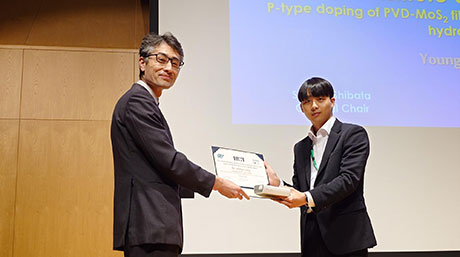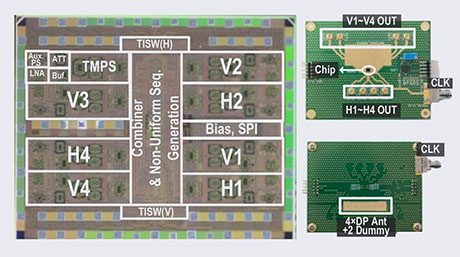Electrical and Electronic Engineering News
Efficient Satellite Downlink with a Ka Band Dual Circular Polarization Transmitter
A new low-loss transmitter allows higher precision low-orbit satellite earth monitoring, according to a study by Tokyo Tech researchers. The novel transmitter works in the Ka band of the microwave frequency spectrum, where no efficient transmission has been possible so far. By using circularly polarized signal, and an innovative internal calibration scheme, efficient transmission with low signal noise and wide-angle scanning is demonstrated.

Low earth orbit (LEO) satellites are being increasingly used for environmental monitoring of the earth, as well for logistic purposes, such as the navigation of maritime vessels. The data transmitted from the satellite terminals to the receivers on Earth, known as "downlink," is steadily increasing and, as a result, requires new frequency domains. In this regard, the Ka band for satellite communication in the microwave frequency range between 17–31 GHz offers several advantages. The Ka band allows for smaller antennas than those for conventional downlink frequencies and a phased array-based transmission, which enables transmission link control independent of the satellite position. However, transmission devices in the Ka range have so far been largely inefficient owing to a degradation of the signal beam polarization with the transmitter changing direction. The degraded polarization appears as noise in the receiver, reducing the signal-to-noise ratio.
Against this backdrop, researchers from Tokyo Institute of Technology (Tokyo Tech), Japan have now proposed, in a new study, what is the first reported dual circular polarization transmitter for satellites in the Ka band based on a standard silicon CMOS process. Their work was presented in the IEEE Radio Frequency Integrated Circuits Symposium![]() and published in the conference proceedings. "In our study, we were able to lower the losses and increase the transmission efficiency by using an adaptive impedance tuning circuitry, realized with a low-loss pi-type transformer-based load tuner. With this innovation, a satellite will be able to transmit to a receiver on earth for a wide range of angles," explains Associate Professor Atsushi Shirane, one of the authors in the study.
and published in the conference proceedings. "In our study, we were able to lower the losses and increase the transmission efficiency by using an adaptive impedance tuning circuitry, realized with a low-loss pi-type transformer-based load tuner. With this innovation, a satellite will be able to transmit to a receiver on earth for a wide range of angles," explains Associate Professor Atsushi Shirane, one of the authors in the study.
In addition to the adaptive impedance circuity, a circular polarization detection circuitry was also integrated to calibrate the circular polarization upon beam steering. "As the load is tuned and the transmitter forms a larger angle with the receiver, the circular polarization deteriorates. This has been a fundamental limitation of using dual circular polarization. But, with our internal calibration for deterioration, this traditional constraint is lifted. This could enable a practical device based on our technology," says Dr. Shirane.
Indeed, as the researchers demonstrated, their innovative transmitter design showed a high power efficiency as well as a high equivalent isotropically radiated power over a wide range of angles (from -60° to +60°).
These findings could pave the way for a significant leap in downlink technology. Further, with growing environmental concerns, low-orbit earth monitoring is likely to become more important. In this light, these results highlight the Ka frequency band as a strong candidate for satellites communication in the years to come.
- Reference
| Authors : | Dongwon You*, Yun Wang, Xi Fu, Hans Herdian, Xiaolin Wang, Ashbir Fadila, Hojun Lee, Michihiro Ide, Sena Kato, Zheng Li, Jian Pang, Atsushi Shirane, Kenichi Okada |
|---|---|
| Session Title : | A Ka-Band Dual Circularly Polarized CMOS Transmitter with Adaptive Scan Impedance Tuner and Active XPD Calibration Technique for Satellite Terminal |
| Conference : | IEEE Radio Frequency Integrated Circuits Symposium |
| Affiliations : | Department of Electrical and Electronic Engineering, Tokyo Institute of Technology, Japan |
|
* Corresponding authors' emails: dongwon@ssc.pe.titech.ac.jp; shirane@ee.e.titech.ac.jp |
|
- Electricity and Data Over-the-Air: The Simultaneous Transmission of 5G and Power | Tokyo Tech News
- Introducing a Transceiver that Can Tap into the Higher Frequency Bands of 5G Networks | Tokyo Tech News
- Lean and mean: Maximizing 5G communications with an energy-efficient relay network | Tokyo Tech News
- Pushed to the Limit: A CMOS-based transceiver for beyond 5G applications at 300 GHz | Tokyo Tech News
- Greater Connectedness in Remote Areas: A Ka-band Transceiver for Satellite Communications | Tokyo Tech News
- Researchers develop a compact 28-GHz transceiver supporting dual-polarized MIMO | Tokyo Tech News
- Smallest all-digital circuit opens doors to 5 nm next-gen semiconductor | Tokyo Tech News
- A more accurate, low-cost 39 GHz beamforming transceiver for 5G communications | Tokyo Tech News
- Kenichi Okada - Wiring the world wirelessly | Research Stories | Research
- Shirane Lab.
- Okada Lab.
- Atsushi Shirane | Researcher Finder - Tokyo Tech STAR Search
- Kenichi Okada | Researcher Finder - Tokyo Tech STAR Search
- Laboratory for Future Interdisciplinary Research of Science and Technology (FIRST)
- Institute for Innovation Research (IIR)
- Electrical and Electronic Engineering Graduate Major|Education|Department of Electrical and Electronic Engineering, School of Engineering
- Electrical and Electronic Engineering Undergraduate Major|Education|Department of Electrical and Electronic Engineering, School of Engineering
- Latest Research News
School of Engineering
—Creating New Industries and Advancing Civilization—
Information on School of Engineering inaugurated in April 2016
Further Information
Associate Professor Atsushi Shirane
Institute of Innovative Research,
Tokyo Institute of Technology
Email shirane@ee.e.titech.ac.jp
Tel +81-3-5734-3764






